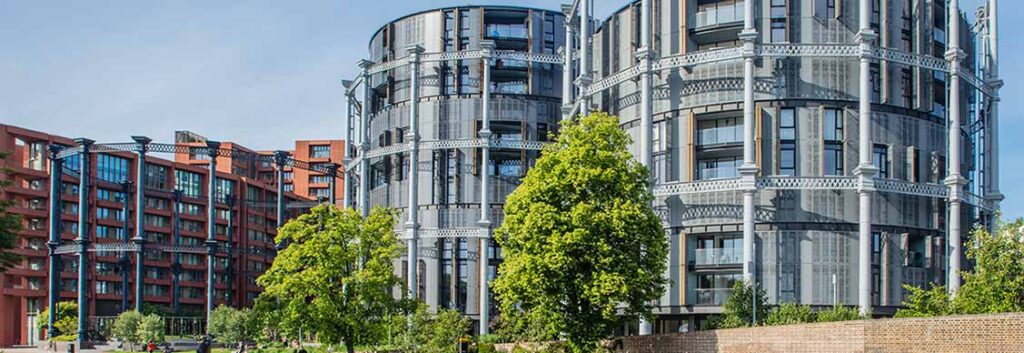12 trends shaping human living
2020 was a critical year for cities and communities. The pandemic affected the core of our urban living, and local governments needed to react quickly to protect people’s lives and simultaneously look for the best approaches to handle the long-term effects of COVID-19.
View the original article here
At the intersection of both these challenges, one topic stands out: the importance of making cities more human and nurturing a strong sense of connection, shedding light on what cities should care about the most – people.
This is the motto of this study and the underlying idea in the 12 trends we present. Committed to helping cities drive change, we have listened to prominent actors in order to understand what we might expect to happen next. Researchers, practitioners, policymakers and city leaders are just some of the people we interviewed, and their insights helped identify 12 trends that cities, leveraging technology and data, can follow on the road to becoming smarter, more sustainable and resilient.
The 12 trends are not equally applicable or desirable for all cities. They cover most of the domains of a city and touch on the main changes emerging from the pandemic. However, we do not suggest that all these trends form a recipe for every city – after all, there is no one-size-fits-all approach to city development.
These are the 12 trends we have identified:
GREEN PLANNING OF PUBLIC SPACES: Cities are being planned and designed for people, with ‘green’ streets, new corridors and public spaces as centers of social life.
SMART HEALTH COMMUNITIES: Cities develop health care ecosystems that are focused not only on diagnosing and treating sickness, but also on supporting well-being through early intervention and prevention, while leveraging digital technologies.
15-MINUTE CITY: Cities are being designed in a way that amenities and most services are within a 15-minute walking or cycling distance, creating a new neighbourhood approach.
MOBILITY: INTELLIGENT, SUSTAINABLE AND AS-A-SERVICE: Cities work towards offering digital, clean, intelligent, autonomous and intermodal mobility, with more walking and cycling spaces, where transport is commonly provided as a service.
INCLUSIVE SERVICES AND PLANNING: Cities evolve to have inclusive services and approaches, fighting inequalities by providing access to housing and infrastructure, equal rights and participation, as well as jobs and opportunities.
DIGITAL INNOVATION ECOSYSTEM: Cities attract talent, enable creativity and encourage disruptive thinking, developing themselves through an innovation model approach and a combination of physical and digital elements.
CIRCULAR ECONOMY AND PRODUCING LOCALLY: Cities adopt circular models based on a healthy circulation of resources, and on principles of sharing, reusing and restoration, with an emphasis on limiting municipal waste volumes and on producing locally – for instance, by urban farming.
SMART AND SUSTAINABLE BUILDINGS AND INFRASTRUCTURE: Cities aim to have regenerated buildings; they leverage data to optimise energy consumption and the use and management of resources in buildings and utilities: waste, water and energy.
MASS PARTICIPATION: Cities evolve to be human-centered and designed by and for their citizens, promoting mass participation by the ecosystem in a collaborative process and following open government policies.
CITY OPERATIONS THROUGH AI: Cities adopt automated processes and operations (orchestrated by a city platform) and are following data-driven planning approaches.
CYBERSECURITY AND PRIVACY AWARENESS: Cities strive to promote awareness of the importance of data privacy and preparedness for the impact of cyberattacks since data will be an important city commodity.
SURVEILLANCE AND PREDICTIVE POLICING THROUGH AI: Cities are leveraging artificial intelligence (AI) to ensure safety and security for their citizens while safeguarding the privacy and fundamental human rights.
Trend 1: GREEN PLANNING OF PUBLIC SPACES
Cities need to be planned and designed for people, with ‘green’ streets, new corridors and public spaces as centers of social life.

Urban areas are traditionally characterized by high population density and heavy construction to support modern amenities, such as transport and commercial buildings. They now face increasing pressure from expanding populations, limited resources and the growing impact of climate change. One of the indicators for measuring SDG 11 is the area of public and green space in a city, as the lack of natural space creates an unhealthy urban living environment.
Cities should be driving a decarbonization agenda. Becoming low carbon is the first step towards mitigating carbon emissions and achieving ecosystem resilience. At the same time, cities should ensure that urban planning is capable of dealing with the pressures of climate change in the adaptation agenda.
Green public spaces entail:
- a large number of trees in cities (Singapore ranks first in the Green View Index from MIT’s Senseable City Lab, which measures the canopy cover in cities);
- creation of more and larger public parks and nature-based solutions in the urban environment, fostering a closer connection to nature even in cities with high population density;
- more walking and cycling facilities instead of car-centric designs and parking areas, with space for children and adults to enjoy outdoor activities, and fostering a sense of security and safety (according to a study by C40, investing in a shift to mass transit and developing walking and cycling corridors can reduce carbon emissions in cities by 5-15 per cent.).
Cities around the world are recognizing the benefits of a green approach to urban planning, as it has the potential to lower urban temperatures, mitigate air pollution and build natural environmental resilience. World Economic Forum’s Global Agenda Council on the Future of Cities has included increasing green canopy cover in its top ten list of urban planning initiatives.
How to ensure successful implementation
- Understand sustainability drivers and societal targets.
- Promote equal, fair and integrated urban planning.
- Do not underestimate the power of community engagement.
- Ensure funding and financing.
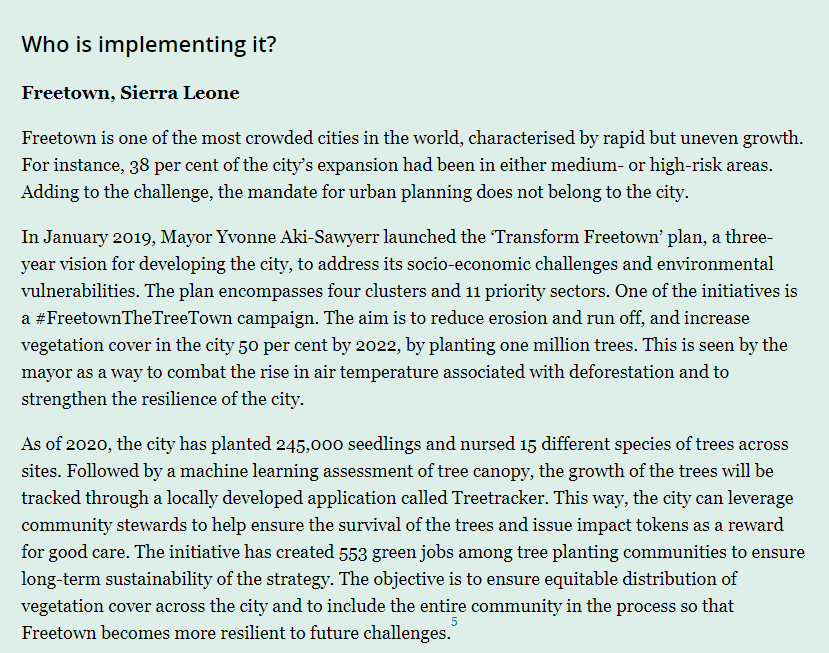
Trend 2: SMART HEALTH COMMUNITIES IN THE CITIES
Cities are developing health care ecosystems that are not only focused on diagnosing and treating sickness but also on supporting well-being through early intervention and prevention, leveraging digital technologies.
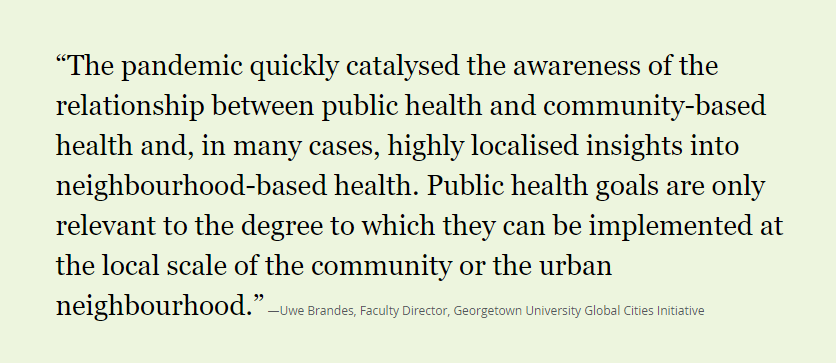
The health crisis during the pandemic made the case clear: there is a community role in creating a better health environment, and cities need to pay more attention to the well-being of their citizens. Globally, five of the top ten causes of death are related to unhealthy behavior. This brings into the spotlight the need for preventive medicine. The factors that affect a person’s health and behavior are complex; therefore communities (physical and virtual) must play a part.
Cities will develop health care ecosystems that move away from a focus purely on diagnosing and treating sickness and injuries to one that is equally focused on supporting well-being through early intervention and prevention. Instead of being designed and funded to treat individual patients one by one, they will have a greater appreciation of the interconnectedness of communities. The social determinants of health will be better understood, and government and the private sector will collaborate to address some of these challenges.
As care moves outside of the hospital walls new community players and disruptors will become critical in forming the new ecosystem. Scientific advancements and the affordability of personalized health care (genomics, micromics, metabolism and behavioral economics) will ensure that care is tailored for individuals and their families. The citizens’ health journey will be underpinned by interoperable data and analytics guiding them through positive health choices and behaviors.
Cities have a responsibility to create a healthy environment. Smart Health Communities (SHCs) engage patients, companies and public entities to deliver digital health services, in order to develop and shape communities, reducing costs dramatically, improving wellness and longevity, and promoting economic growth. Governments act as enablers of change by promoting this interconnected health care ecosystem. A city, as a geographical SHC, can drive a shift towards preventive and curative therapies, as well as provide solutions that foster collective and cooperative healthy behavior, and generate and analyze interoperable data to predict risks and evaluate impact. While privacy is a concern, investment in smart public health initiatives generates substantial return on investment for cities while improving public health and well-being.
How to ensure successful implementation
- Work to generate trust.
- Invest in a data privacy and security infrastructure.
- Establish partnerships between public and private stakeholders, namely government agencies, technology companies, health care and life sciences players, the media, NPOs/NGOs, social care entities and citizens.
- Collaborate with technology companies to launch awareness-creation programs and knowledge-sharing platforms.
- Establish community-driven funding hubs to strengthen the reach and support capabilities and operational efficiency of SHCs.
- Restructure policies and consider incentivizing SHC development plans.
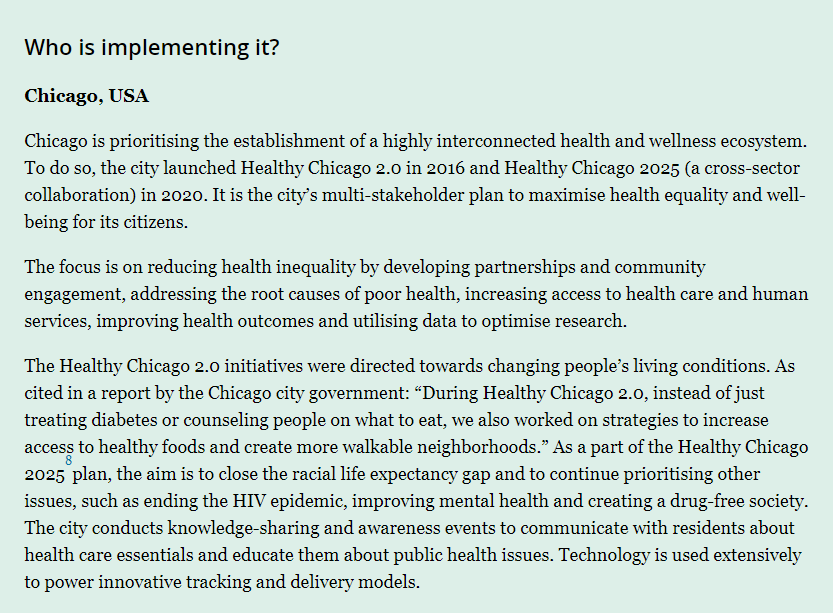
Trend 3: THE 15-MINUTE CITY
Cities are being designed so that amenities and most services are within a 15-minute walking or cycling distance, creating a new neighborhood approach.

The ‘15-minute’ city concept – primarily developed to reduce carbon emissions by reducing the use of cars and motorized commuting time – is a decentralized urban planning model, in which each local neighborhood contains all the basic social functions for living and working. Many people argue that the concept of creating localized neighborhoods in which residents can get everything they require within 15 minutes by walking, cycling or on public transport will ultimately improve the quality of life. Such spaces entail multipurpose neighborhoods instead of separate zones for working, living and entertainment, which reduces the need for unnecessary travel, strengthens a sense of community and improves sustainability and liveability.
Today most cities have ‘operation-based’ neighborhoods, with separate areas used predominantly for business or entertainment. Fragmented urban planning results in a sprawl, with people having to travel long distances across the city to get to their destination. In contrast, compact cities of the future, or ‘hyperlocalization’, prioritize strategies for urban infrastructure that aim to bring all the elements for living and working into local neighborhood communities.
The ‘15-minute’ city is an iteration of the idea of ‘neighborhood units’ developed by American planner Clarence Perry during the 1920s. The theory of ‘new urbanism’, an urban planning and design concept promoting walkable cities, subsequently gained popularity in the US in the 1980s. Similar versions of ‘urban cells’ or 30- and 20-minute neighbourhoods have also emerged across the globe in the past decade.
The rezoning model will gain further traction in the future, boosted during the COVID-19 disruption, by new ways of working that require less transport. With climate change as a major global concern, C40 in its “C40 Mayors’ Agenda for a Green and Just Recovery” has recommended this model for cities worldwide, arguing that its pedestrianization approach contributes to a reduction in greenhouse gas emissions and supports environmental sustainability.
While this approach may not be entirely applicable to every city – for example, it is probably more suitable for a big metropolis than for smaller cities – remote working and the digitalization of services have increased the impetus to apply the principle of neighborhood planning regardless of city size.
How to ensure successful implementation
- Correlate sustainability goals and urban planning initiatives.
- Ensure community endorsement.
- Decentralize core services.
- Launch schemes to promote affordable housing in every neighborhood.
- Allow flexible use of urban spaces and properties across neighborhoods.
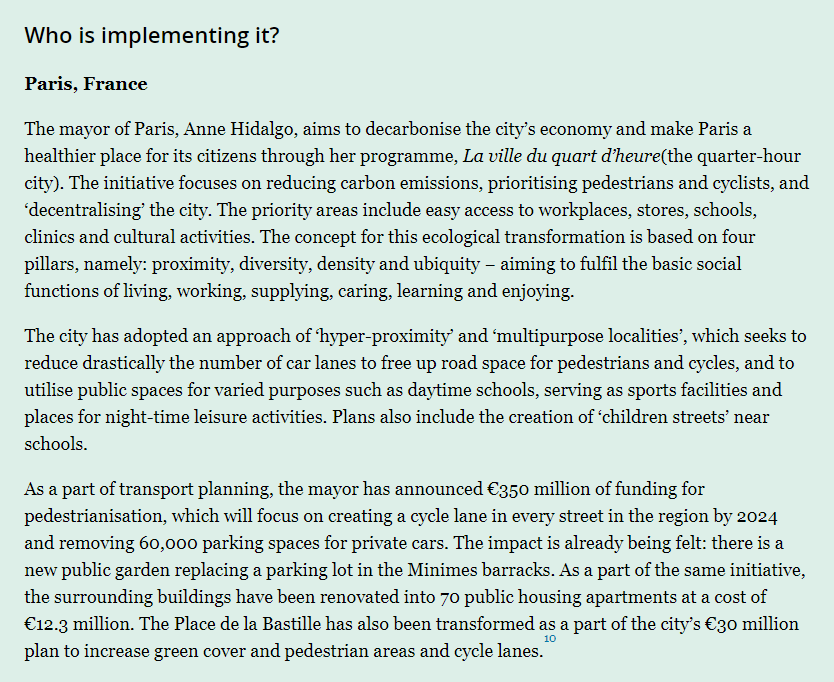
Trend 4: MOBILITY: INTELLIGENT, SUSTAINABLE AND AS-A-SERVICE
Cities are working towards offering digital, clean, intelligent, autonomous and intermodal mobility, with more walking and cycling spaces, where transport is commonly provided as a service.

This is one area where cities should expect huge disruption. Some major changes in how people move around in cities are already under way, but the trend will accelerate further in the next decade, with electrification, autonomous driving, smart and connected infrastructure, modal diversity, and mobility that is integrated, resilient, shared and sustainable – powered by disruptive business models. In answers to an ESI ThoughtLab survey question, 54 per cent of city leaders admitted they will rethink mobility and transportation in the aftermath of the COVID-19 pandemic.
Less need to travel. It is expected that in general people will travel less than they have in the past. With new urban planning concepts such as the ‘15-minute city’ promoting compact environments, ‘connected corridors’ and changes in the way that people work, movements within urban areas will decrease substantially and bicycles, scooters and even walking will increasingly be the preferred options in community neighborhoods.
Electrification. It is estimated that in 2030, electric vehicles (EVs) will have around 32 per cent of the total market share for new car sales globally, although there will be differences between regions.
Connectivity and automation. Recent Deloitte research in the United States estimates that by 2040, up to 80 per cent of passenger miles travelled in urban areas could be in shared autonomous vehicles. This development will be led by major technology-based corporations or the automotive and transport sector and by technology-based start-ups. Solutions such as passenger drones by EHang and drone delivery by Amazon are making rapid advances. Logistics companies look increasingly to autonomous technology to meet the rising demand for goods.
Sharing. Cities will also benefit from an increase in on-demand multimodal mobility and Mobility-as-a-Service (MaaS) platforms, such as in Helsinki. For instance, residents will be able to plan and book door-to-door trips digitally, use the same fare card for all transport modes, access automated last-mile cargo shipment services, and have end-to-end real-time visibility of freight in transit – and with seamless payment models.
Intelligent mobility. With data playing a central role in some of these shifts, customised travel is something that cities will start to deliver, segmenting their customers (citizens) in a mobility context and implementing strategies for each market segment. The value of ‘intelligent’ mobility is forecast to grow to €850 billion by 2025, representing more than 1 per cent of global GDP.
How to ensure successful implementation • Embrace a holistic approach (and consider the total mobility mix), and start with a minimal viable ecosystem for ‘smart mobility’, adding features over time in an agile way.
• Invest in infrastructure – physical, energy, digital and telecoms – that supports effective transformation.
- Be aware that a new generation of vehicles is needed, and there should be a resurgence in the use of some existing types of vehicles, such as motorbikes and bicycles, with a strong focus on micromobility.
- Make mobility management a priority, both management of assets (infrastructure and vehicles) and management of clients (people).
- Make sure regulation adapts to the new circumstances, covering vehicle security and liability in cases of accidents, data management and privacy, interoperability, connectivity, risk and responsibility, and cybersecurity.
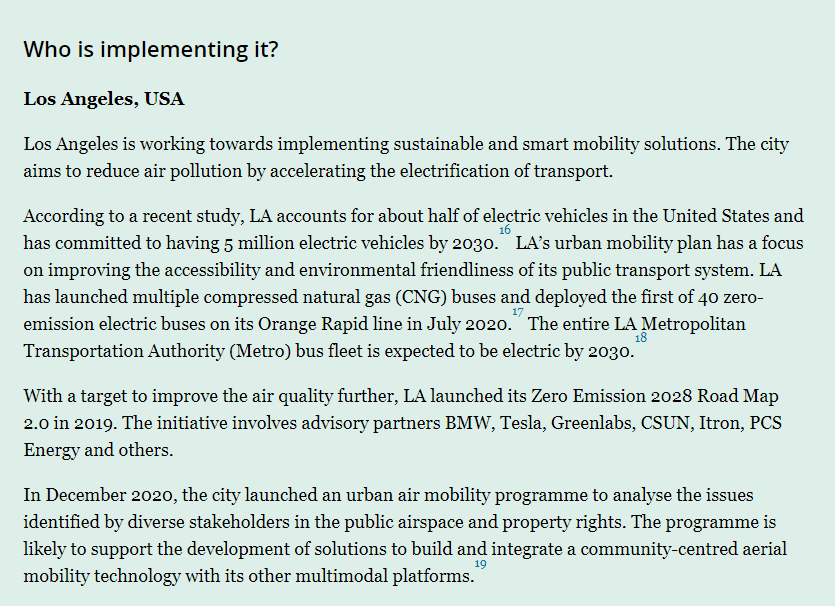
Trend 5: INCLUSIVE SERVICES AND PLANNING
Cities are evolving to have inclusive services and approaches, fighting inequalities by providing access to housing and infrastructure, equal rights and participation, and jobs and opportunities.

Cities are not only centers of economic development; they symbolize equality, healthy communal coexistence and prosperity for all. Social inclusion should be a key pillar of urban growth and development for the cities of the future, bearing in mind the three building blocks identified by World Bank: spatial inclusion (providing affordable housing, water and sanitation), social inclusion (expanding equal rights and participation) and economic inclusion (creating jobs and offering citizens opportunities for economic development).
Cities should be planned and designed to generate social and economic outcomes for everyone, avoiding the costs that occur when people are excluded. Although the poor are usually the most affected, cities will also remove the barriers caused by differences in gender, race, nationality, disability or religion. Inclusive design could mean building gender-inclusive urban centers to provide safe and secure spaces for carers and installing wheelchair-accessible features for those with mobility difficulties. Inclusive design may mean building greener and safer neighborhoods for all citizens and investing to create secure and joyful spaces for children to play and accessible places for the elderly, making cities pleasurable for the silver generation. An inclusive social care system will embrace migrants and offer them tailored services that address their particular needs and circumstances, just as for everyone else.
There are already some signs of cities prioritizing inclusion. A survey of 167 cities worldwide found that 40-47 per cent use metrics to track progress towards inclusion goals, although the majority are in advanced economies.
Digitalization enables governments to facilitate access to a range of services, accelerate business opportunities, analyze societal gaps, educate mass audiences, collect real-time data, boost data-driven decision-making, facilitate predictive and proactive governance, and engage larger audiences in social activity. It also frees up government capacity to re-direct finite administrative and case management resources to those who need it most.
Although a fundamental requirement for social inclusion, technology may also create disparities. City planners should remain aware of the large numbers of ‘digitally invisible’ citizens, to avoid skewing the results of city analysis that would compromise urban planning efforts and even contribute to widening the inequality gap.
How to ensure successful implementation
- Implement proactive multisector solutions, both preventive and curative.
- Promote an integrated planning approach instead of a fragmented one.
- Follow an equity-centered by design approach.
- Improve the adoption of technology solutions and digital skills, supported by adjusted regulation.
- Pursue data equity.
- Establish inclusive living labs.
- Use agile methods to respond rapidly and anticipate citizens’ needs.
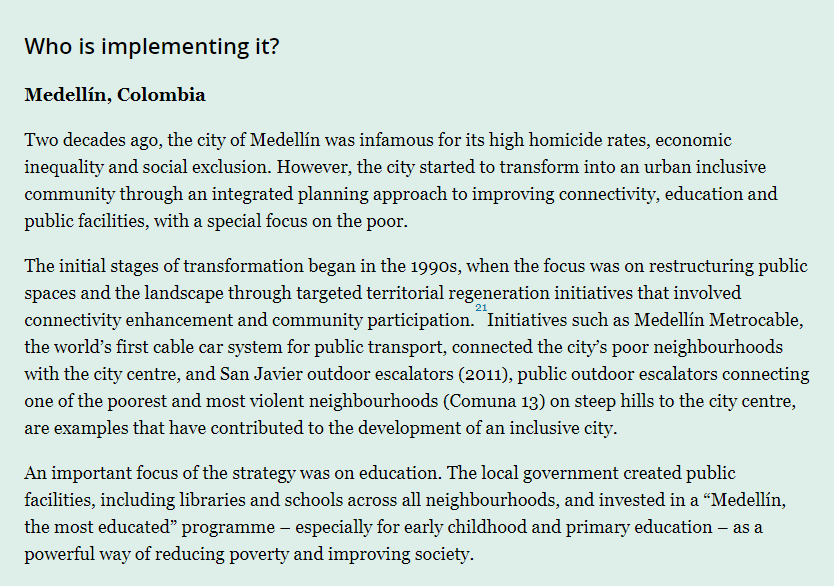
Trend 6: THE CITY AS A DIGITAL INNOVATION ECOSYSTEM
Cities strive to attract talent, enable creativity and encourage disruptive thinking; developing themselves through an innovation model approach and a combination of physical and digital elements.

While traditionally companies and industrial parks have been concentrated in suburbs of the city, start-ups and digital nomads are bringing innovation and ideas to the city centres. As population numbers increase in urban areas, cities compete for investment, skilled workers (talent) and cultural prominence, and this is turning urban regions into innovation hubs, leveraging data.
In some cities with an innovation or technology department, individuals try to innovate from a silo. This is not what we mean. Cities will adopt a multidimensional approach to innovation, the so-called quintuple innovation helix framework (of interactions between university, industry, government, public and environment), and city governments will act as platforms enabling the right connections, policies, places and infrastructure to make the ecosystem flourish; solving the town’s most prominent challenges and bringing positive change to the city and its industries.
Cities will be Living Labs for digital transformation and centers of experimentation, using data to develop pilots that can be scaled up. By putting talent attraction at the center of its strategy, a city can develop with the goal of being the most attractive host (of people, companies and research centers), in order to facilitate ecosystem development. The City Hall has to develop the right skills, and data collection and usage, and modernize its governance model to foster collaboration and encourage open innovation. Increasing the level of adoption of digital innovation in high-priority economic sectors generates a positive impact on local competitiveness, by opening up new sources of employment and economic growth. It also supports the uptake of disruptive and promising digital technologies. Remote working has lengthened the list of cities that can adopt this strategic approach. In line with the ‘rise of the rest’ theory put forward by Richard Florida in 2019, the shift from enterprise attraction to talent attraction makes it possible for smaller cities to thrive in a post-pandemic world, using data as a source of competitiveness in the digital innovation environment. It is a time for small remote hubs.
How to ensure successful implementation
- Create capacity to attract talent, expertise and open talent networks.
- Foster agile processes and avoid a risk-aversion culture.
- Add the required skill sets and gain an awareness of the opportunities that new technologies offer.
- Ensure data mastery and interoperability standards.
- Embrace a new way of management and leadership.
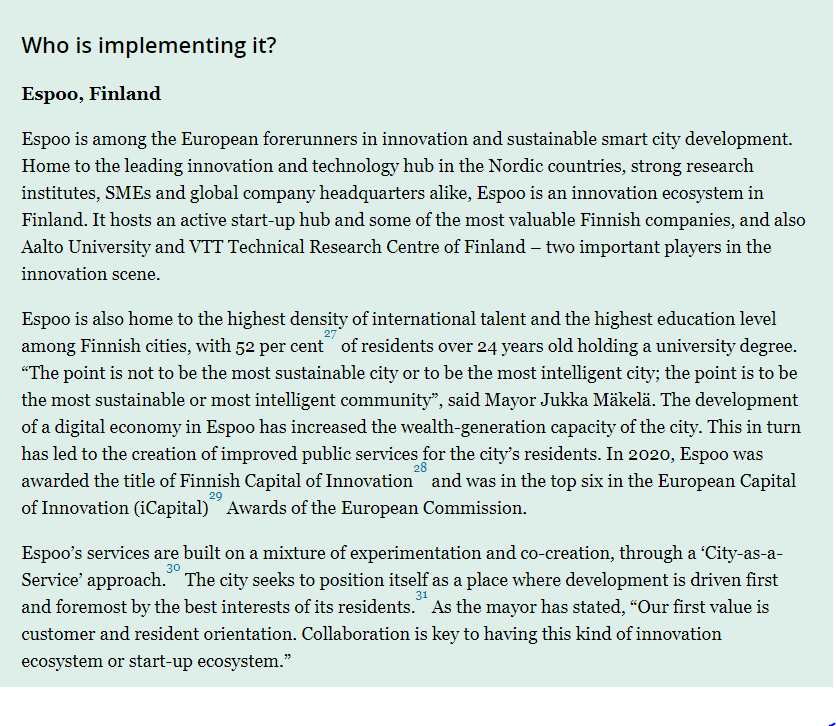
Trend 7: CIRCULAR ECONOMY AND LOCAL PRODUCTION IN THE CITY
Cities are adopting circular models based on a healthy circulation of resources; principles of sharing, reusing and restoring; and with emphasis on limiting municipal waste volumes and on producing locally – for instance, urban farming.

Do you know that on average a car is parked more than 90 per cent of the time? Or that the average office is used only 35-50 per cent of the time? That 30 per cent of food is wasted? That half of the waste is produced in cities? Increasingly, cities are developing aspects of a circular economy, which entails decoupling economic activity from the consumption of finite resources and designing waste out of the system.
What does it mean to live in a city with a circular economy? It is a city that:
- promotes a better use of resources through procurement policies;
- consumes less, and reuses and recycles water, energy, products and materials;
- recycles and manages waste according to regulations;
- stimulates an economy of repair, borrowing and second-hand commerce;
- nurtures a sharing mindset (e.g., car trips, spaces and materials);
- fosters better use of resources in construction (e.g., 10-15 per cent of building materials are wasted during construction);
- stimulates an innovative approach to how the city and its citizens consume, store and use resources.
A circular economic model is one of the pillars of the European Union’s European Green Deal strategy, and there are already some examples of its application, as well as policies and mechanisms to fund the transition. Cities will also increasingly encourage a ‘produce local’ approach to food and energy. Urban and small-scale farming is gaining traction in some urban centers as a way to deliver fresh and healthy food, establish direct contact with food producers and reduce carbon emissions, while strengthening the local economy. Innovative approaches make better use of space and light, such as vertical farming, hydroponics, LED indoor farming and rooftop farming. Simultaneously, the energy revolution is contributing to the circular economy through decentralization of energy production, mainly through renewable sources (biogas, wind, solar, wood biomass, waste, etc.), and off-grid and microgenerators, paving the way for self-sufficiency whereby cities generate as much energy as they consume, creating communities of energy and offering further economic opportunities.
How to ensure successful implementation
- Secure funding for the transition.
- Establish flexible and simple regulatory structures and smart procurement.
- Create or rethink metrics to measure circularity.
- Leverage national or regional policies and invest in awareness campaigns.
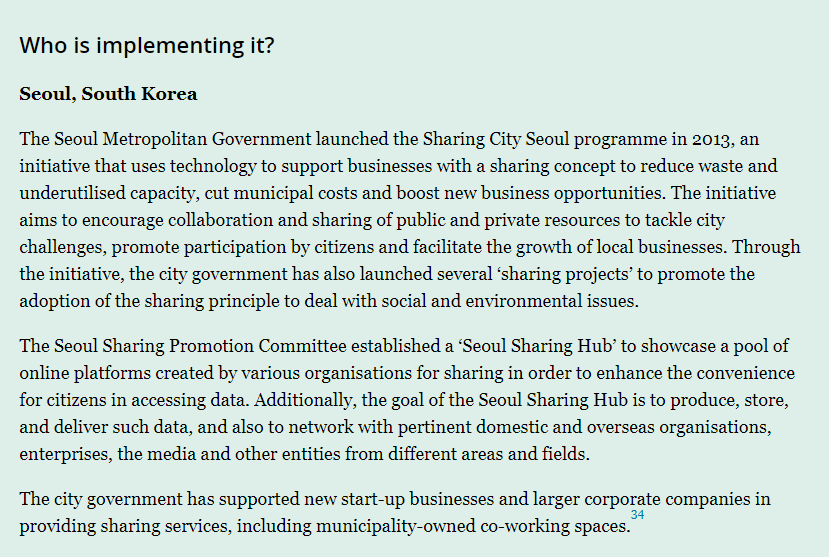
Trend 8: SMART AND SUSTAINABLE BUILDINGS AND INFRASTRUCTURES
Cities aim to have regenerated buildings and to leverage data to optimise energy consumption and the use and management of resources in buildings and utilities: waste, water and energy.
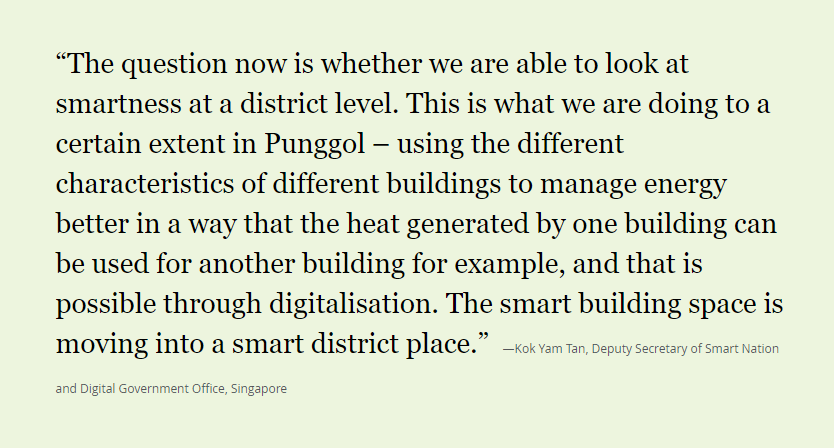
In 2019, the Coalition for Urban Transitions estimated that it should be possible to cut emissions from cities by about 90 per cent by 2050 (15.5 GtCO2e by 2050) using proven technologies and practices, in particular for buildings and infrastructure. Estimated cuts include 36.5 per cent from residential buildings and 21.2 per cent from commercial buildings. Buildings are currently responsible for 30-40 per cent of total city emissions. To achieve the COP21 target by 2050, emissions from buildings must be 80-90 per cent lower than they are today.
Many buildings are energy inefficient and contribute heavily to carbon emissions. In the EU, as of February 2020, roughly 75 per cent of building stock was energy inefficient. So there is some way to go. A 2019 Navigant report stated that only 5 per cent of the smart city projects that it tracked had a focus primarily on building innovation, and just 13 per cent had ‘some level’ of focus on buildings.
World Green Building Council defines a green building as one that, “in its design, construction or operation, reduces or eliminates negative impacts, and can create positive impacts, on our climate and natural environment; preserve precious natural resources and improve our quality of life”.9 Given the pressure on cities to act on climate change, green buildings are going to invade our urban centers. Besides being built with sustainable and ethical materials, they will be energy, water and resources-efficient; environment-friendly by design – powered by renewables (such as solar) and capable of producing their own energy (electricity prosumers); covered by vertical and/or rooftop gardens; and able to provide a better indoor environment for those who live in them or use them.
On top of that, they will leverage data and digital technology to enable components of infrastructure to become more efficient and better adapted to the stakeholders’ usage. Business models provided by flexible office operators will foster an Office-as-a-Service or even Real Estate-as-a-Service approach.
Gartner predicts that by 2028 there will be more than 4 billion connected IoT devices in commercial smart buildings. They will be powered by telecommunications infrastructures, with 5G and High Efficiency Wi-Fi (6 or 6E) at the forefront, and smart utilities such as power, waste and water.
As of May 2020, 28 major cities have signed up for the World Green Building Council’s Net Zero Carbon Buildings Commitment, which calls for cities to reach net-zero carbon operations by 2030 for all assets under their direct control, and to advocate for all buildings to become net-zero carbon in operations by 2050.
How to ensure successful implementation
• Define a vision and technological guidelines, and develop a roadmap.
• Stimulate and prioritise sustainability-targeted renovation, construction and restoration projects.
• Launch incentive plans to promote alternate materials and build a strong engagement ecosystem.
• Beyond investing in buzzwords like 5G or sensory-tech solutions, extract value from data.
• Promote data-sharing standards and policy.
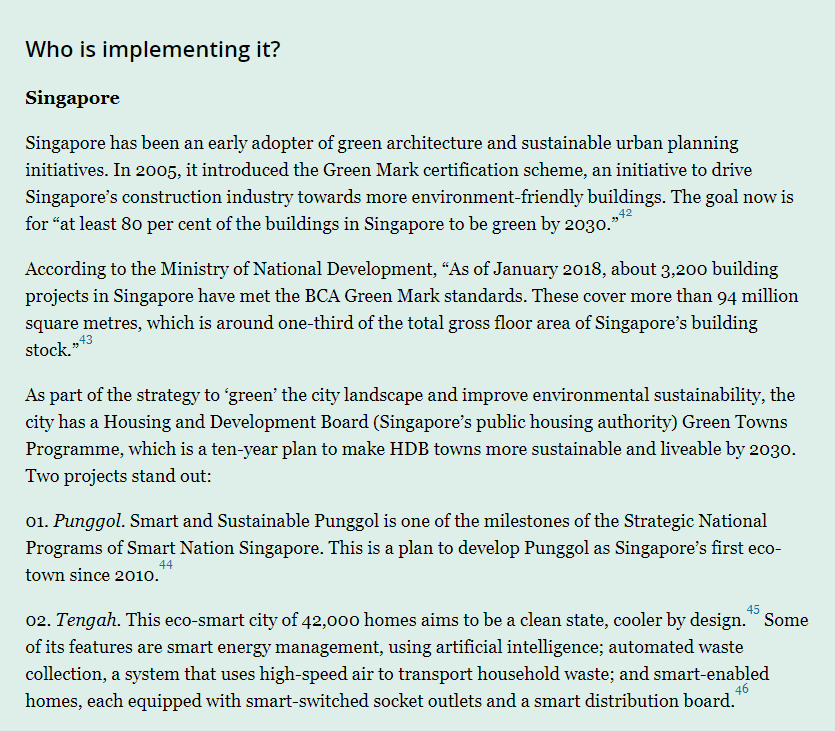
Trend 9: MASS PARTICIPATION IN CITY BUILDING AND DEVELOPMENT
Cities are evolving to be human-centred and designed by and for their citizens, promoting mass participation by the ecosystem in a collaborative process and following open government policies.
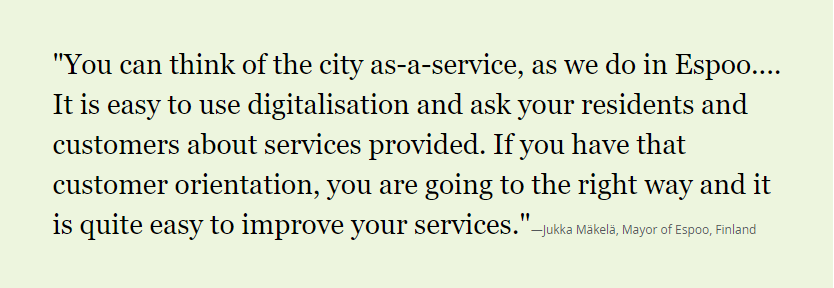
What does an ideal experience in our city look like? How can our city contribute to a brighter global future? How would we like our children to grow up in the city? What would we like our city to be known for around the world?
These are some of the questions you will be asked in cities where there is open government and mass participation. These are places where citizens, social innovators, civil society organisations, businesses and academia are part of the process of building their cities (in a quintuple helix model), closing the gaps between local government and the ecosystem.
Through mass participation, supported by open data and technology, and with local government acting as a platform, cities can use citizens as a ‘sensor’ and benefit from greater innovation, better utilisation of resources and an increased sense of ownership. Co-creation through mass participation is a bi- or multidirectional human-centred approach, rather than just a bottom-up or traditional top-down approach.
Cities are increasingly innovative in the way they promote participation, and technology plays a key role in enabling innovation – for instance, mobile applications and reporting websites overcome the need for groups to meet in person to discuss new ideas and collaborate; and digital currency opens the door to gamification strategies. But to ensure the three principles of open government are met (participation, collaboration and transparency), it is necessary to have open data platforms and other initiatives. Participatory budgets are a good starting point. Some cities go a step further and provide citizens and the ecosystem with real-time access to information, to keep them informed about changes that affect where they live. Ultimately, cities will progress towards having true platforms for collaboration, fostering co-creation and leading to new governance models (co-governance), where responsibility is shared among the participants and is not just a burden on the local government. From this perspective, a new culture is created, and citizen engagement emerges as critical for ensuring the long-term sustainability of policy initiatives.
How to ensure successful implementation
- Engage the city population at scale and combine physical and virtual interactions whenever possible.
- Follow the digital imperative, but create a smart population for smart cities.
- Ensure accessibility and inclusiveness for all citizens.
- Establish clear governance processes and transparency to boost trust – an enabler of open governments and collaboration.
- Align objectives and expectations, and make clear connections between participation and decisions taken.
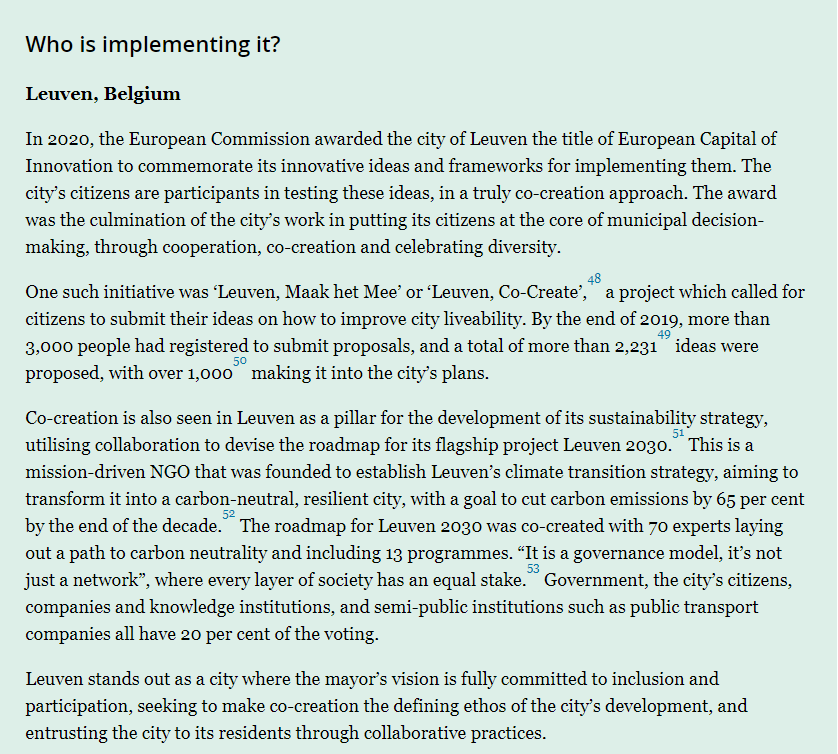
Trend 10: CITY OPERATIONS THROUGH AI
Cities are adopting automated processes and operations (orchestrated by a city platform) and following data-driven planning approaches.

Machines run 24/7, and there are operations and tasks that cities perform that will become increasingly smart and powered by artificial intelligence (AI). AI will contribute to the optimisation of operational efficiencies, benefiting city managers, and ultimately citizens, through reshaped service delivery. In an ESI ThoughtLab study, 66 per cent of 167 cities surveyed are investing heavily in AI, and 80 per cent will do so over the next three years.
While chat assistants are currently among the most common solutions powered by AI, cities will evolve to have digital platforms as ‘city brains’, where all urban activity is orchestrated and operated, providing a holistic view of the city, allowing for events correlation, fast and assertive root-cause analysis, predictive analysis (through machine learning) and incident management; and providing operational insights through visualisation. If the behaviour of almost every citizen is registered through anonymised data, and 5G technology enables cities to become huge connected ecosystems, it will be of paramount importance to maximise data value and improve planning and decision-making using AI and data analytics, on the way to a cognitive city. Gartner predicted in 2019 that a city platform will be a mature smart city solution in five to ten years’ time, when it is expected that 1-5 per cent of cities will be using a city platform to manage their operations.
But cities can go even further. We see cities like Dublin and Singapore, among others, creating a Digital Twin – a dynamic digital replica of their physical assets and environments and their interdependencies – for urban planning purposes and using machine learning to predict future events and trends. Digital Twins will become increasingly powerful in enabling data-driven decisions and will have a high adoption rate among city governments, with the promise of making cities more resilient. ABI research has predicted that by 2025 the number of urban Digital Twins will exceed 500.
How to ensure successful implementation
- Start with data strategy and governance.
- Be aware of privacy issues, and stimulate a culture of trust.
- Ensure data standards and interoperability.
- Avoid algorithmic bias.
- Develop the right skill sets among the city workforce.
- Follow a citizen-focused approach to operations.
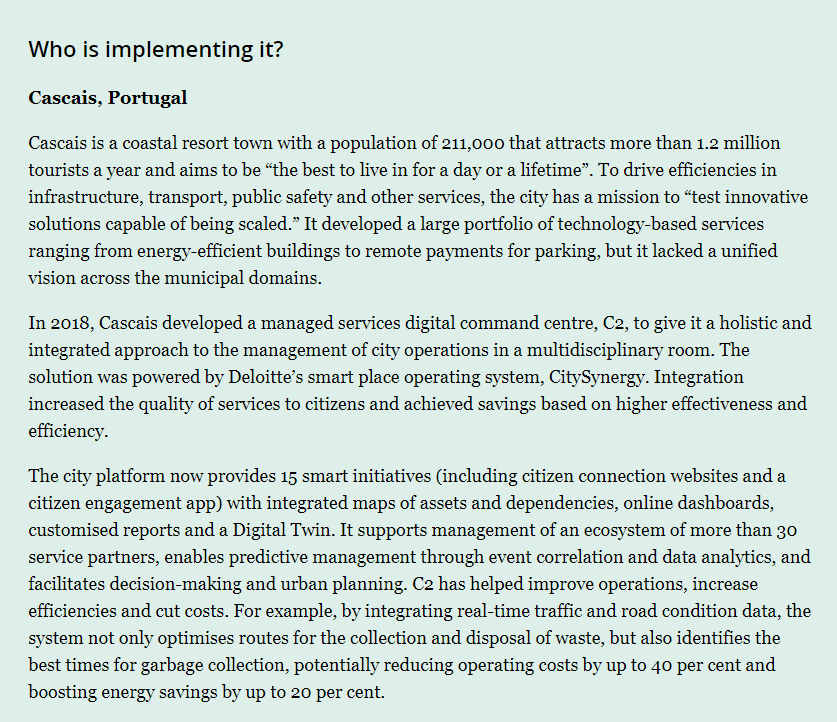
Trend 11: CYBERSECURITY AND PRIVACY AWARENESS IN THE CITY
Cities strive to promote awareness of the importance of data privacy and to get prepared for the impact of cyberattacks, since data will be an important city commodity.
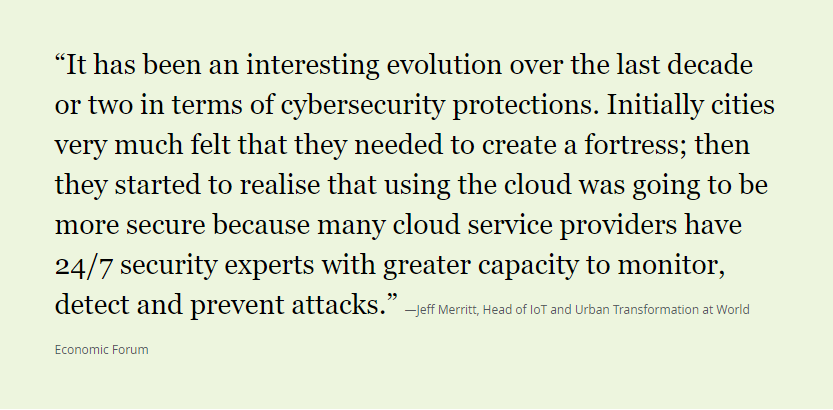
As services are becoming highly integrated and interconnected, and vulnerabilities created during data exchanges are more common, data security is vitally important. In 2018, the total cost of losses from cyberattacks for cities in a survey averaged €2.8 million.
Cybersecurity is now a key consideration for developers and planners of smart cities, and attention is turning to the risks inherent in such a highly interconnected environment. However, while the cybersecurity industry has developed a mature understanding of how to measure and mitigate the impact of cyberattacks on infrastructure in ‘non-smart’ cities, there is limited knowledge of the potential impact of attacks on smart cities.
An attack on smart city infrastructure may create effects that cascade – or ‘ripple’ – outwards and affect other parts of the city or country, or beyond. Resilience is the essential concept that must be considered when creating these complex and highly interconnected environments. It is essential to use resilience as a cornerstone of city building, and to do so in a way that can be scaled up and remain flexible for future upgrades and enhancements.
As the complexity of technologies, operational interdependencies, and systems management increases, so does the interest of hackers in profiting from this environment. Developing smart city initiatives without considering cybersecurity and privacy can result in a highly vulnerable environment that poses security risks to critical infrastructure and data, and in some cases may even create safety risks for citizens.
Advance planning is essential. By one estimate, 95 per cent of Cities 4.0 (as labelled by ESI ThoughtLab, referring to hyper-connected cities that use technology, data, and citizen engagement in pursuit of the SDGs) ensure that cybersecurity is considered early in the process, compared with only 51 per cent of other cities.
However, many cities are not ready for the challenges. Besides lagging far behind in the digital revolution, with outdated technologies running critical infrastructure, they lack the human resource expertise to be capable of addressing the challenges. Creating ecosystems of innovation – as Tel Aviv has done – could be one approach to improving security. Another approach is to invest in models of public/private cooperation and coordination. Efforts must be backed by city executives and not left to external entities or departments alone.
How to ensure successful implementation
- Ensure three major goals:
- Govern like a nation.
- Treat smart cities as a defensive ecosystem.
- Reboot with resilience.
- Syncronise the city with cyber strategy, and allow for flexibility.
- Have a clear cyber and data governance in place, with accountability.
- Leverage the ecosystem and build strategic partnerships to grow cyber capabilities.
- Align regulation policies.
- Adopt a specific tool to manage the cybersecurity landscape of a smart city.
- Invest in awareness campaigns on privacy.
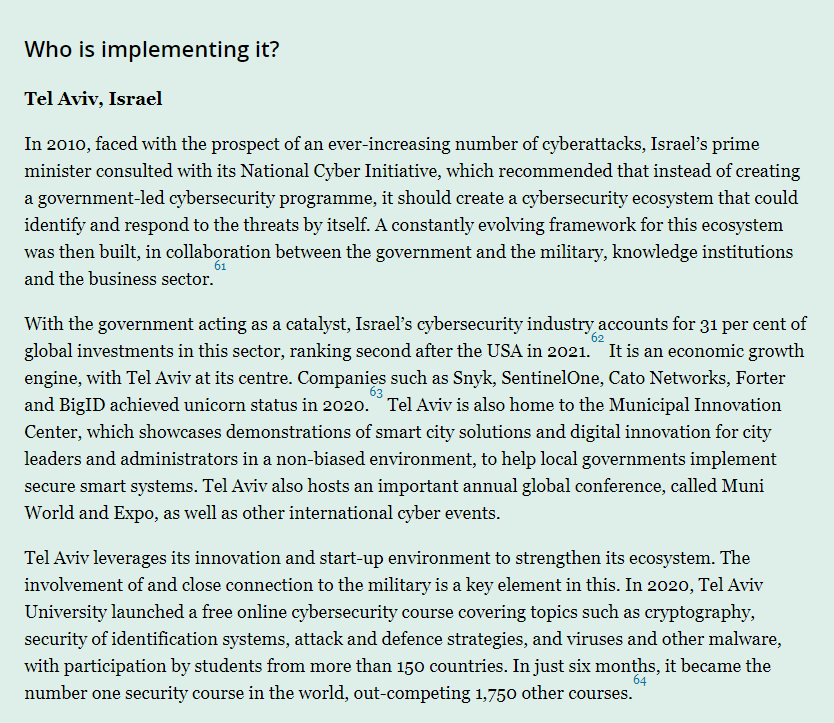
Trend 12: SURVEILLANCE AND PREDICTIVE POLICING THROUGH AI
Cities are leveraging artificial intelligence (AI) to ensure safety and security for their citizens while safeguarding privacy and fundamental human rights.
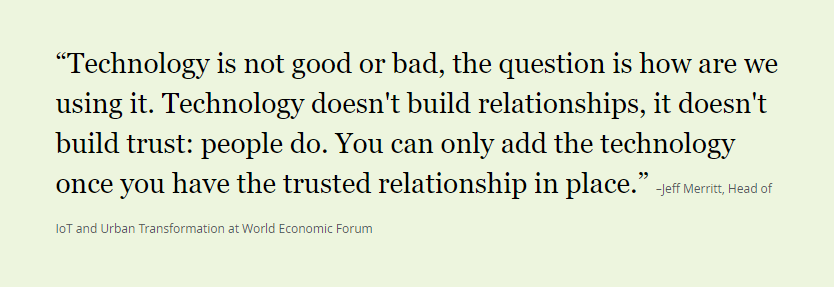
Surveillance and predictive policing through AI is the most controversial trend in this report, but one that has important implications for the future of cities and societies.
Technology is frequently used as a synonym for evolution, but the ethics of its use may need to be questioned. An underlying question is what society we are aiming to build. There are doubts and uncertainties about the impact of AI on communities and cities: the most fundamental concern is privacy, but there are frequent debates about AI from other perspectives, such as its impact on jobs, the economy and the future of work. Therefore, one cannot disconnect the discussion about surveillance and predictive policing from recent debates about the societal, ethical and even geopolitical dimensions.
The pace of adoption of AI for security purposes has increased in recent years. AI has recently helped create and deliver innovative police services, connect police forces to citizens, build trust and strengthen associations with communities. There is growing use of smart solutions such as biometrics, facial recognition, smart cameras and video surveillance systems. A recent study found that smart technologies such as AI could help cities reduce crime by 30 to 40 per cent and reduce response times for emergency services by 20 to 35 per cent. The same study found that cities have started to invest in real-time crime mapping, crowd management and gunshot detection. Cities are making use of facial recognition and biometrics (84 per cent), in-car and body cameras for police (55 per cent), drones and aerial surveillance (46 per cent), and crowdsourcing crime reporting and emergency apps (39 per cent) to ensure public safety. However, only 8 per cent use data-driven policing. The International Data Corporation (IDC) has predicted that by 2022, 40 per cent of police agencies will use digital tools, such as live video streaming and shared workflows, to support community safety and an alternative response framework.
Surveillance is not new, but cities are exploring the capabilities of predicting crime by analyzing surveillance data, in order to improve security. Cities already capture images for surveillance purposes, but by using AI, images can now be analyzed and acted on much more quickly. Machine learning and big data analysis make it possible to navigate through huge amounts of data on crime and terrorism, to identify patterns, correlations and trends. When the right relationships are in place, technology is the layer that supports law enforcement agencies to better deliver their job and trigger behavior change. The ultimate goal is to create agile security systems that can detect crime, terrorism networks and suspicious activity, and even contribute to the effectiveness of justice systems.
How to achieve these goals while respecting privacy and liberties remains a crucial question.
Experts say it is almost impossible to design broadly adopted ethical AI systems, because of the enormous complexity of the diverse contexts they need to encompass. Any advances in AI for surveillance and predictive policing need to be accompanied by discussions about ethical and regulatory issues. Even though the value proposition of these technologies might seem attractive from a use case perspective, liberties and civil rights need to be protected by proper privacy and human rights regulations.
In summary, cities need to consider if using technology for surveillance and policing implies making concessions to convenience at the expense of freedom.
How to ensure a successful implementation?
- Balance security interests with the protection of civil liberties, including privacy and freedom.
- Experiment responsibly, and regulate first.
- Establish institutional review boards that include experts from multiple disciplines.
- Create mechanisms for monitoring and reviewing algorithms.
- Privilege the usage of environmental data instead of personal data.
- Promote strong collaboration and trust between law enforcement systems and citizens.
- Accompany digitalisation with a change in culture.


